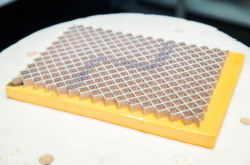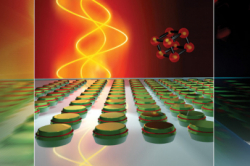Topological insulators are unique in that they conduct electric current only along the surface while remaining insulated inside. A peculiar protected state is formed on the surface in which electrons in the current are impervious to any external effects or material defects. The current thus runs through the material in one direction without reflection or loss.
Although scientists have been studying electrical topological insulators for several decades now, similar structures for electromagnetic waves were described only in 2009. The first such prototype was quite bulky, with limited application in optical frequency range. The situation changed in 2015 when physicists from the Laboratory for Nanophotonics and Metamaterials of ITMO University and the Australian National University became the first to design and build a compact electromagnetic topological insulator. The structure provided full and unprecedented control over light localisation at the nanoscale.

"Our study began with a one-dimensional structure. Basically, this was a chain of nanodisks where the electromagnetic field was localized at a particular edge,” – says Dr. Alexey Slobozhanyuk, member of the Laboratory of Nanophotonics and Metamaterials. – “My colleague Alexander Poddubny proposed a theoretical concept and together with Ivan Sinev and Anton Samusev we performed experiments for both microwaves and optics. Our research from 2015 was highlighted in Optics and Photonic News; back then, this topic was quite new and no one had even thought about three-dimensional photonic topological insulators. Global recognition of our work encouraged us to go forward with our research in this field."
Next, the scientists got involved in the development of two-dimensional topological insulators. Professor Alexander Khanikaev from the City University of New York suggested how it could be done theoretically. This idea was implemented in 2016 when an article about the first experimental two-dimensional photonic insulator was published. This experiment was performed with metallic metamaterials.

Alexey Slobozhanyuk
"The signal in such a structure is localized on an artificially created domain wall which guides the light around sharp corners even in the presence of defects. However, that concept could not be used for optics due to strong absorption in metals,” – adds Alexey Slobozhanyuk. – “We started to consider dielectric metamaterials to avoid losses, and later performed our first successful experiment with them."
While working on two-dimensional structures, researchers discovered that topological protection of electromagnetic waves is also possible in the three dimensions. Detailed theoretical research published in Nature Photonics this year confirmed the existence of three-dimensional topological insulators.
"Using three-dimensional photonic topological insulators we can make light waves behave in ways that were thought to be technically impossible”, – says Prof. Alexander Khanikaev. – “Currently, we cannot design an optical waveguide without surface defects. As a result, the signal gradually decreases and finally vanishes. With the help of topological systems we are able to avoid any optical losses."

Alexander Khanikaev
The team has already started experiments with three-dimensional insulators and development of the devices based on them.
"It is much more difficult to conduct experiments with a three-dimensional structure, but Alexey Slobozhanyuk and his colleagues from ITMO University are working hard on this. Alexey is preparing to finish his PhD in Australia now and then he is going to return to ITMO University in order to establish and develop a new research field,” – says Yuri Kivshar, Research Director of the International Center for Nanophotonics and Metamaterials of ITMO University and Distinguished Professor of the Australian National University.

Yuri Kivshar
Optics & Photonics News highlighted the research on three-dimensional photonic topological insulators in the special December issue “Optics in 2017”. It highlights the 30 most exciting peer-reviewed optics research that has emerged over the past 12 month.
"Optics and Photonic News is very prestigious among scientists. This year the editorial team stressed the importance of our results by placing an image of our three-dimensional photonic topological insulator on the cover of the special issue,” – says Alexey Slobozhanyuk. – ”When your work is recognized in such a way, you know how important and useful your efforts are”.
Reference: «Topological Photonics Goes Three-Dimensional», Alexey Slobozhanyuk, Yuri S. Kivshar, Alexander B. Khanikaev. Optics and Photonics News Dec. 1, 2017







